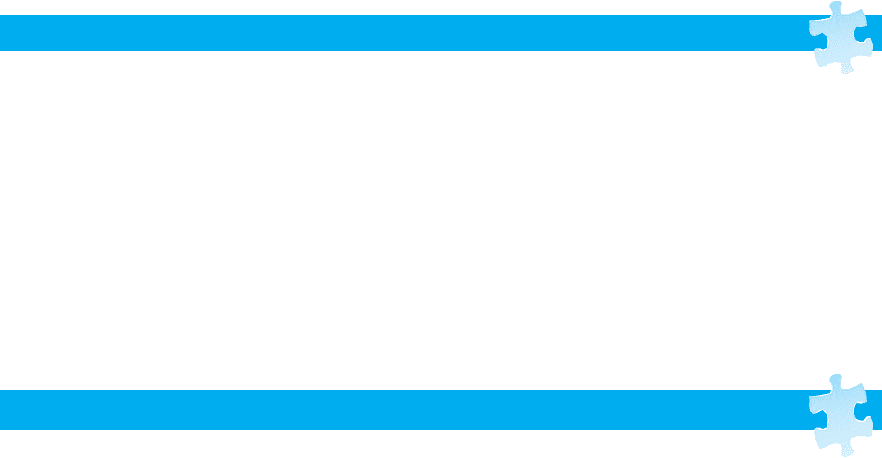Jackson S.L. Research Methods and Statistics: A Critical Thinking Approach
Подождите немного. Документ загружается.

192
■ ■
CHAPTER 7
After the observed and expected frequencies have been determined, we
can calculate
2
as follows:
2
(O E)
2
________
E
where O is the observed frequency, E is the expected frequency, and indi-
cates that we must sum the indicated fractions for each category in the study
(in this case, for the pregnant and not pregnant groups). Using this formula
with the present example, we have
2
(7 14)
2
________
14
(73 66)
6
_________
66
(7)
2
_____
14
(7)
2
____
66
49
___
14
49
___
66
3.5 0.74
4.24
Interpreting the
2
Goodness-of-Fit Test
The null hypothesis is rejected if
obt
2
is greater than
cv
2
. The
cv
2
is
found in Table A.4 in Appendix A. To use the table, you need to know
the degrees of freedom for the
2
test. This is the number of categories
minus 1. In our example, we have two categories (pregnant and not preg-
nant); thus, we have 1 degree of freedom. At alpha .05, then,
cv
2
3.84. Our
obt
2
of 4.24 is larger than the critical value, so we can reject the
null hypothesis and conclude that the observed frequency of pregnancy
is significantly lower than expected by chance. In other words, the female
teens at the target high school have a significantly lower pregnancy rate
than would be expected based on the statewide rate. In APA style, the
result is reported as
2
(1, N 80) 4.24, p .05
Assumptions and Appropriate Use of the
2
Goodness-of-Fit Test
Although the
2
goodness-of-fit test is a nonparametric test and therefore
less restrictive than a parametric test, it does have its own assumptions. First,
the test is appropriate for nominal (categorical) data. If data are measured on
a higher scale of measurement, they can be transformed to a nominal scale.
Second, the frequencies in each expected frequency cell should not be too
small. If the frequency in any expected frequency cell is too small ( 5), then
the
2
test should not be conducted. Last, to be generalizable to the popula-
tion, the sample should be randomly selected and the observations must be
independent. In other words, each observation must be based on the score
of a different participant.
10017_07_ch7_p163-201.indd 192 2/1/08 1:25:00 PM

Hypothesis Testing and Inferential Statistics
■ ■
193
Correlation Coefficients and Statistical
Significance
You may remember from Chapter 6 that correlation coefficients are used to
describe the strength of a relationship between two variables. For example,
we learned how to calculate the Pearson product-moment correlation coef-
ficient, which is used when the variables are of interval or ratio scale. At
that time, however, we did not discuss the idea of statistical significance. In
this case, the null hypothesis (H
0
) is that the true population correlation is
.00—the variables are not related. The alternative hypothesis (H
a
) is that the
observed correlation is not equal to .00—the variables are related. But what
if we obtain a rather weak correlation coefficient, such as .33? Determining
the statistical significance of the correlation coefficient will allow us to
decide whether or not to reject H
0
.
To test the null hypothesis that the population correlation coefficient is
.00, we must consult a table of critical values for r (the Pearson product-
moment correlation coefficient) as we have done for the other statistics
discussed in this chapter. Table A.5 in Appendix A shows critical values for
both one- and two-tailed tests of r. A one-tailed test of a correlation coeffi-
cient means that we have predicted the expected direction of the correlation
coefficient (i.e., predicted either a positive or negative correlation), whereas
a two-tailed test means that we have not predicted the direction of the cor-
relation coefficient.
To use this table, we first need to determine the degrees of freedom,
which for the Pearson product-moment correlation are equal to N
2,
The
2
Goodness-of-Fit Test IN REVIEW
CONCEPT DESCRIPTION
2
goodness-of-fit test A nonparametric inferential hypothesis test that examines how well an observed
frequency distribution of a nominal variable fits some expected pattern of
frequencies
Observed frequencies The frequencies observed in the sample
Expected frequencies The frequencies expected in the sample based on some pattern of frequencies such
as those in the population
CRITICAL
THINKING
CHECK
7.6
1. How does the
2
goodness-of-fit test differ in use from the previously
described z test and t test? In other words, when should it be used?
2. Why is the
2
goodness-of-fit test a nonparametric test, and what
does this mean?
10017_07_ch7_p163-201.indd 193 2/1/08 1:25:00 PM

194
■ ■
CHAPTER 7
where N represents the total number of pairs of observations. If the cor-
relation coefficient of .33 is based on 20 pairs of observations, then the
degrees of freedom are 20 2 18. After the degrees of freedom are deter-
mined, we can consult the critical values table. For 18 degrees of freedom
and a two-tailed test at alpha .05, r
cv
is ±.4438. This means that r
obt
must
be that large or larger to be statistically significant at the .05 level. Because
our r
obt
is not that large, we fail to reject H
0
. In other words, the observed
correlation coefficient is not statistically significant. You might remember
that the correlation coefficient calculated in Chapter 6 between height
and weight was .94. This was a one-tailed test (we expected a positive
relationship) and there were 20 participants in the study. Thus, the degrees
of freedom are 18. Consulting Table A.5 in Appendix A, we find that
the r
cv
is ±.3783. Because the r
obt
is larger than this, we can conclude that the
observed correlation coefficient is statistically significant. In APA style, the
result is reported as
r (18) .94, p .05 (one-tailed)
Summary
In this chapter, we introduced hypothesis testing and inferential statistics.
The discussion of hypothesis testing included the null and alternative
hypotheses, one- and two-tailed hypothesis tests, and Type I and Type II
errors in hypothesis testing. In addition, we defined the concept of statisti-
cal significance. The simplest type of hypothesis testing—a single-group
design in which the performance of a sample is compared with that of the
general population—was used to illustrate the use of inferential statistics in
hypothesis testing.
We described two parametric statistical tests: the z test and the t test.
Each compares a sample mean with the general population. Because both are
parametric tests, the distributions should be bell-shaped, and certain param-
eters should be known (in the case of the z test, and must be known; for
the t test, only is needed). In addition, because the tests are parametric, the
data should be interval or ratio in scale. These tests use the sampling distri-
bution (the distribution of sample means). They also use the standard error
of the mean (or estimated standard error of the mean for the t test), which is
the standard deviation of the sampling distribution. Both z tests and t tests
can test one- or two-tailed alternative hypotheses, but one-tailed tests are
more powerful statistically.
Nonparametric tests are those for which population parameters ( and )
are not needed. In addition, the underlying distribution of scores is not
assumed to be normal, and the data are most commonly nominal (categori-
cal) or ordinal in nature. We described and used the chi-square goodness-of-
fit nonparametric test, which is used for nominal data.
Last, we revisited correlation coefficients with respect to significance
testing. We learned how to determine whether an observed correlation coef-
ficient is statistically significant by using a critical values table.
10017_07_ch7_p163-201.indd 194 2/1/08 1:25:00 PM

Hypothesis Testing and Inferential Statistics
■ ■
195
In Chapters 9 to 11, we will continue our discussion of inferential statis-
tics, looking at statistical procedures appropriate for experimental designs
with two or more equivalent groups and those appropriate for designs with
more than one independent variable.
hypothesis testing
inferential statistics
null hypothesis (H
0
)
alternative hypothesis (H
a
), or
research hypothesis (H
1
)
one-tailed hypothesis (directional
hypothesis)
two-tailed hypothesis
(nondirectional hypothesis)
Type I error
Type II error
statistical significance
single-group design
parametric test
nonparametric test
z test
sampling distribution
standard error of the mean
central limit theorem
critical value
region of rejection
statistical power
confidence interval
t test
Student’s t distribution
degrees of freedom
estimated standard error of the
mean
chi-square (
2
) goodness-of-fit test
observed frequency
expected frequency
KEY TERMS
(Answers to odd-numbered exercises appear in
Appendix C.)
1. The admissions counselors at Brainy University
believe that the freshman class they have just
recruited is the brightest yet. If they want to test
this belief (that the freshmen are brighter than
the other classes), what are the null and alter-
native hypotheses? Is this a one- or two-tailed
hypothesis test?
2. To test the hypothesis in Exercise 1, the admis-
sions counselors select a random sample of
freshmen and compare their scores on the SAT
with those of the population of upperclassmen.
They find that the freshmen do in fact have a
higher mean SAT score. However, they are una-
ware that the sample of freshmen was not repre-
sentative of all freshmen at Brainy University. In
fact, the sample overrepresented those with high
scores and underrepresented those with low
scores. What type of error (Type I or Type II) did
the counselors make?
3. A researcher believes that family size has
increased in the past decade in comparison to
the previous decade—that is, people are now
having more children than they were before.
What are the null and alternative hypotheses in
a study designed to assess this? Is this a one- or
two-tailed hypothesis test?
4. What are the appropriate H
0
and H
a
for each of
the following research studies? In addition, note
whether the hypothesis test is one- or two-tailed.
a. A study in which researchers want to test
whether there is a difference in spatial ability
between left- and right-handed people
b. A study in which researchers want to test
whether nurses who work 8-hour shifts
deliver higher-quality care than those who
work 12-hour shifts
c. A study in which researchers want to
determine whether crate-training puppies is
superior to training without a crate
5. Assume that each of the following conclu-
sions represents an error in hypothesis testing.
Indicate whether each of the statements is a Type
I or II error.
a. Based on the data, the null hypothesis is
rejected.
b. There is no significant difference in quality
of care between nurses who work 8- and
12-hour shifts.
CHAPTER EXERCISES
10017_07_ch7_p163-201.indd 195 2/1/08 1:25:01 PM
196
■ ■
CHAPTER 7
c. There is a significant difference between
right- and left-handers in their ability to per-
form a spatial task.
d. The researcher fails to reject the null hypoth-
esis based on these data.
6. How do inferential statistics differ from descrip-
tive statistics?
7. A researcher is interested in whether students
who attend private high schools have higher
average SAT scores than students in the general
population. A random sample of 90 students at a
private high school is tested and has a mean SAT
score of 1050. The average score for public high
school students is 1000 ( 200).
a. Is this a one- or two-tailed test?
b. What are H
0
and H
a
for this study?
c. Compute z
obt
.
d. What is z
cv
?
e. Should H
0
be rejected? What should the
researcher conclude?
f. Determine the 95% confidence interval for the
population mean, based on the sample mean.
8. The producers of a new toothpaste claim that
it prevents more cavities than other brands of
toothpaste. A random sample of 60 people use
the new toothpaste for 6 months. The mean
number of cavities at their next checkup is 1.5. In
the general population, the mean number of
cavities at a 6-month checkup is 1.73 ( 1.12).
a. Is this a one- or two-tailed test?
b. What are H
0
and H
a
for this study?
c. Compute z
obt
.
d. What is z
cv
?
e. Should H
0
be rejected? What should the
researcher conclude?
f. Determine the 95% confidence interval for
the population mean, based on the sample
mean.
9. Why does t
cv
change when the sample size
changes? What must be computed to determine t
cv
?
10. Henry performed a two-tailed test for an experi-
ment in which N 24. He could not find his
table of t critical values, but he remembered the
t
cv
at df 13. He decided to compare his t
obt
with
this t
cv
. Is he more likely to make a Type I or a
Type II error in this situation?
11. A researcher hypothesizes that people who listen
to music via headphones have greater hear-
ing loss and will thus score lower on a hearing
test than those in the general population. On a
standard hearing test, the overall mean is 22.5.
The researcher gives this same test to a random
sample of 12 individuals who regularly use
headphones. Their scores on the test are 16, 14,
20, 12, 25, 22, 23, 19, 17, 17, 21, 20.
a. Is this a one- or two-tailed test?
b. What are H
0
and H
a
for this study?
c. Compute t
obt
.
d. What is t
cv
?
e. Should H
0
be rejected? What should the
researcher conclude?
f. Determine the 95% confidence interval for the
population mean, based on the sample mean.
12. A researcher hypothesizes that individuals who
listen to classical music will score differently
from the general population on a test of spatial
ability. On a standardized test of spatial ability,
58. A random sample of 14 individuals who
listen to classical music is given the same test.
Their scores on the test are 52, 59, 63, 65, 58, 55,
62, 63, 53, 59, 57, 61, 60, 59.
a. Is this a one- or two-tailed test?
b. What are H
0
and H
a
for this study?
c. Compute t
obt
.
d. What is t
cv
?
e. Should H
0
be rejected? What should the
researcher conclude?
f. Determine the 95% confidence interval for the
population mean, based on the sample mean.
13. When is it appropriate to use a
2
test?
14. A researcher believes that the percentage of peo-
ple who exercise in California is greater than the
national exercise rate. The national rate is 20%. The
researcher gathers a random sample of 120 indi-
viduals who live in California and finds that the
number who exercise regularly is 31 out of 120.
a. What is
obt
2
?
b. What is df for this test?
c. What is
cv
2
?
d. What conclusion should be drawn from these
results?
15. A teacher believes that the percentage of students
at her high school who go on to college is higher
than the rate in the general population of high
school students. The rate in the general popula-
tion is 30%. In the most recent graduating class
at her high school, the teacher found that 90 stu-
dents graduated and that 40 of those went on to
college.
a. What is
obt
2
?
b. What is df for this test?
c. What is
cv
2
?
d. What conclusion should be drawn from these
results?
10017_07_ch7_p163-201.indd 196 2/1/08 1:25:02 PM

Hypothesis Testing and Inferential Statistics
■ ■
197
7.1
1. H
0
:
southern children
children in general
H
a
:
southern children
children in general
This is a one-tailed test.
2. The researcher concluded that there was a dif-
ference when, in reality, there was no difference
between the sample and the population. This is a
Type I error.
3. With the .10 level of significance, the researcher
is willing to accept a higher probability that the
result may be due to chance. Therefore, a Type
I error is more likely to be made than if the
researcher used the more traditional .05 level of
significance. With a .01 level of significance, the
researcher is willing to accept only a .01 prob-
ability that the result may be due to chance. In
this case, a true result is more likely to be missed,
meaning that a Type II error is more likely.
7.2
1. Inferential statistics allow researchers to make
inferences about a population based on sample
data. Descriptive statistics simply describe a
data set.
2. Single-sample research allows researchers to
compare sample data with population data. The
hypothesis tested is whether the sample per-
forms similarly to the population or whether the
sample differs significantly from the population
and thus represents a different population.
7.3
1. A sampling distribution is a distribution of sam-
ple means. Thus, rather than representing scores
for individuals, the sampling distribution plots
the means of samples of a set size.
2.
X
is the standard deviation for a sampling dis-
tribution. It therefore represents the standard
deviation for a distribution of sample means.
is the standard deviation for a population of
individual scores rather than sample means.
3. A z test compares the performance of a sam-
ple with the performance of the population by
indicating the number of standard deviation
units the sample mean is from the population
mean. A z-score indicates how many standard
deviation units an individual score is from the
population mean.
7.4
1. Predicting that psychology majors will have
higher IQ scores makes this a one-tailed test.
H
0
:
psychology majors
general population
H
a
:
psychology majors
general population
2.
X
15
_____
___
60
15
____
7.75
1.94
z
102.75 100
____________
1.94
2.75
____
1.94
1.42
Because this is a one-tailed test, z
cv
±1.645. The
z
obt
1.42. We therefore fail to reject H
0
and
conclude that psychology majors do not differ
significantly on IQ scores from the general popu-
lation of college students.
7.5
1. The z test is used when the sample size is greater
than 30, normally distributed, and is known.
The t test is used when the sample size is
smaller than 30, bell-shaped but not normal, and
is not known.
2. H
0
:
runners
other athletes
H
a
:
runners
other athletes
X 51.75
s 7.32
60
s
X
7.32
____
__
8
7.32
____
2.83
2.59
t
51.75 – 60
_________
2.59
8.25
______
2.59
3.19
df 8 1 7
t
cv
±1.895
t
obt
3.19
Reject H
0
. The runners’ pulses are significantly
slower than the pulses of athletes in
general.
7.6
a. The
2
test is a nonparametric test used with
nominal (categorical) data. It examines how
well an observed frequency distribution of a
nominal variable fits some expected pattern
of frequencies. The z test and t test are for use
with interval and ratio data. They test how far
a sample mean falls from a population mean.
CRITICAL THINKING CHECK ANSWERS
10017_07_ch7_p163-201.indd 197 2/1/08 1:25:02 PM

198
■ ■
CHAPTER 7
b. A nonparametric test is one that does
not involve the use of any population
parameters, such as the mean and standard
deviation. In addition, a nonparametric test
does not assume a bell-shaped distribution.
Thus, the
2
test is nonparametric because it
fits these assumptions.
Check your knowledge of the content and key terms
in this chapter with a practice quiz and interactive
flashcards at http://academic.cengage.com/
psychology/jackson, or, for step-by-step practice and
information, check out the Statistics and Research
Methods Workshops at http://academic.cengage
.com/psychology/workshops.
WEB RESOURCES
For hands-on experience using statistical software
to complete the analyses described in this chap-
ter, see Chapters 2 “The z Statistic,” 4 “Sampling
Distributions,” 5 “Probability,” 6 “The t Statistic—
One Sample,” and 10 “Nonparametric Statistics,”
and Exercises 2.1–2.2, 4.1–4.2, 5.1, 6.1–6.4, and 10.1
in The Excel Statistics Companion Version 2.0 by
Kenneth M. Rosenberg (Wadsworth, 2007).
STATISTICAL SOFTWARE RESOURCES
CHAPTER 7 SUMMARY AND REVIEW: HYPOTHESIS TESTING AND INFERENTIAL STATISTICS
This chapter consisted of an introduction to hypoth-
esis testing and inferential statistics. There was a
discussion of hypothesis testing including the null
and alternative hypotheses, one- and two-tailed
hypothesis tests, and Type I and Type II errors in
hypothesis testing. In addition, the concept of sta-
tistical significance was defined. The most simplistic
use of hypothesis testing—a single-group design—in
which the performance of a sample is compared to
the general population, was presented to illustrate
the use of inferential statistics in hypothesis testing.
Two parametric statistical tests were described—the
z test and the t test. Each compares a sample mean to
the general population. Because both are parametric
tests, the distributions should be bell-shaped, and
certain parameters should be known (in the case of
the z test, an must be known; for the t test, only
is needed). In addition, because these are parametric
tests, the data should be interval or ratio in scale.
These tests involve the use of the sampling distribu-
tion (the distribution of sample means). They also
involve the use of the standard error of the mean (or
estimated standard error of the mean for the t test),
which is the standard deviation of the sampling dis-
tribution. Both z tests and t tests can test one- or two-
tailed alternative hypotheses, but one-tailed tests are
more powerful statistically. One nonparametric test
was described, the chi-square goodness-of-fit test. As
a nonparametric test, the chi-square goodness-of-fit
test is based on a distribution that is not normal, and
parameters such as and are not needed.
Lastly, the concept of correlation coefficients was
revisited with respect to significance testing. This
involved learning how to determine whether an
observed correlation coefficient is statistically signifi-
cant by using a critical values table.
Chapter 7
■
Study Guide
10017_07_ch7_p163-201.indd 198 2/1/08 1:25:03 PM

Hypothesis Testing and Inferential Statistics
■ ■
199
CHAPTER SEVEN REVIEW EXERCISES
(Answers to exercises appear in Appendix C.)
FILL-IN SELF TEST
Answer the following questions. If you have trouble
answering any of the questions, restudy the relevant
material before going on to the multiple-choice self
test.
1. The hypothesis predicting that no difference
exists between the groups being compared is the
.
2. An alternative hypothesis in which the researcher
predicts the direction of the expected difference
between the groups is a
.
3. An error in hypothesis testing in which the
null hypothesis is rejected when it is true is a
.
4. When an observed difference, say between two
means, is unlikely to have occurred by chance, we
say that the result has .
5. tests are statistical tests that
do not involve the use of any population
parameters.
6. A
is a distribution of sample
means based on random samples of a fixed size
from a population.
7. The
is the standard deviation of
the sampling distribution.
8. The set of distributions that, although symmetri-
cal and bell-shaped, are not normally distributed
is called the
.
9. The
is a parametric statistical
test of the null hypothesis for a single sample
where the population variance is not known.
10.
and frequen-
cies are used in the calculation of the
2
statistic.
MULTIPLE-CHOICE SELF TEST
Select the single best answer for each of the following
questions. If you have trouble answering any of the
questions, restudy the relevant material.
1. Inferential statistics allow us to infer something
about the
based on the .
a. sample; population
b. population; sample
c. sample; sample
d. population; population
2. The hypothesis predicting that differences exist
between the groups being compared is the
hypothesis.
a. null
b. alternative
c. one-tailed
d. two-tailed
3. Null hypothesis is to alternative hypothesis as
is to .
a. effect; no effect
b. Type I error; Type II error
c. no effect; effect
d. both b and c
4. One-tailed hypothesis is to directional hypothesis
as
hypothesis is to hypothesis.
a. null; alternative
b. alternative; null
c. two-tailed; nondirectional
d. two-tailed; one-tailed
5. When using a one-tailed hypothesis, the researcher
predicts:
a. the direction of the expected difference
between the groups.
b. only that the groups being compared will dif-
fer in some way.
c. nothing.
d. only one thing.
6. In a study on the effects of caffeine on driving
performance, researchers predict that those in
the group that is given more caffeine will exhibit
10017_07_ch7_p163-201.indd 199 2/1/08 1:25:04 PM

200
■ ■
CHAPTER 7
worse driving performance. The researchers are
using a
hypothesis.
a. two-tailed
b. directional
c. one-tailed
d. both b and c
7. A conservative statistical test is one that:
a. minimizes both Type I and Type II errors.
b. minimizes Type I errors but increases Type II
errors.
c. minimizes Type II errors but increases Type I
errors.
d. decreases the chance of Type II errors.
8. In a recent study, researchers concluded that
caffeine significantly increased stress levels. What
the researchers were unaware of, however, was
that several of the participants in the no caffeine
group were also taking anti-anxiety medications.
The researchers’ conclusion is a error.
a. Type II
b. Type I
c. null hypothesis
d. alternative hypothesis
9. When alpha is .05, this means that:
a. the probability of a Type II error is .95.
b. the probability of a Type II error is .05.
c. the probability of a Type I error is .95.
d. the probability of a Type I error is .05.
10. The sampling distribution is a distribution of:
a. sample means.
b. population mean.
c. sample standard deviations.
d. population standard deviations.
11. A one-tailed z test is to as a two-tailed
z test is to
.
a. ±1.645; ±1.96
b. ±1.96; ±1.645
c. Type I error; Type II error
d. Type II error; Type I error
12. Which of the following is an assumption of the
t test?
a. The data should be ordinal or nominal.
b. The population distribution of scores should
be normal.
c. The population mean () and standard devia-
tion () are known.
d. The sample size is typically less than 30.
13. Parametric is to nonparametric as
is to
.
a. z test; t test
b. t test; z test
c.
2
test; z test
d. t test;
2
test
14. Which of the following is an assumption of
2
tests?
a. It is a parametric test.
b. It is appropriate only for ordinal data.
c. The frequency in each expected frequency cell
should be less than 5.
d. The sample should be randomly selected.
SELF TEST PROBLEMS
1. A researcher is interested in whether students
who play chess have higher average SAT scores
than students in the general population. A ran-
dom sample of 75 students who play chess is
tested and has a mean SAT score of 1070. The
average () is 1000 ( = 200).
a. Is this a one- or two-tailed test?
b. What are H
0
and H
a
for this study?
c. Compute z
obt
.
d. What is z
cv
?
e. Should H
0
be rejected? What should the
researcher conclude?
f. Calculate the 95% confidence interval for
the population mean, based on the sample
mean.
2. A researcher hypothesizes that people who listen
to classical music have higher concentration skills
than those in the general population. On a stand-
ard concentration test, the overall mean is 15.5.
The researcher gave this same test to a random
10017_07_ch7_p163-201.indd 200 2/1/08 1:25:04 PM

Hypothesis Testing and Inferential Statistics
■ ■
201
sample of 12 individuals who regularly listen to
classical music. Their scores on the test follow:
16 14 20 12 25 22 23 19 17 17 21 20
a. Is this a one- or two-tailed test?
b. What are H
0
and H
a
for this study?
c. Compute t
obt
.
d. What is t
cv
?
e. Should H
0
be rejected? What should the
researcher conclude?
f. Calculate the 95% confidence interval for
the population mean, based on the sample
mean.
3. A researcher believes that the percentage of
people who smoke in the South is greater than
the national rate. The national rate is 15%. The
researcher gathers a random sample of 110 indi-
viduals who live in the South and finds that the
number who smoke is 21 out of 110.
a. What statistical test should be used to analyze
these data?
b. Identify H
0
and H
a
for this study.
c. Calculate
obt
2
.
d. Should H
0
be rejected? What should the
researcher conclude?
10017_07_ch7_p163-201.indd 201 2/1/08 1:25:04 PM
